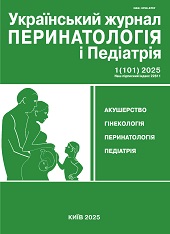Assessment of physical development indicators of preterm infants of the Carpathian region at the stage of catamnestic observation
DOI:
https://doi.org/10.15574/PP.2025.1(101).9095Keywords:
premature children, physical development, follow-up observationAbstract
Aim - to analyze the features of physical development of prematurely born children who were under follow-up observation during the first year of the life for early detection of deviations and their timely correction.
Materials and methods. 29 Medical records of follow-up observation of prematurely born children aged from 0 up to 12 months were processed. All prematurely born children were divided into three groups at birth: with low weight - 1500-2500 g, with very low weight - 1000-1499 g and with extremely low weight - less than 1000 g. Physical development was assessed once a month according to body weight, head circumference and body length conserning the age. The obtained data were statistically processed using Microsoft Office Excel.
Results. It was established that in 1 year the body weight in the groups I, II and III increased by 5, 6, 9 times, respectively. Head circumference during the first year in the all groups corresponded to gestational age. The increase of body length in the groups I, II and III at the age of 1 year was 1.6, 1.8, 1.9 times, respectively. The highest growth rates in the first year of the life in terms of body weight, head circumference and body length were observed in premature children in the groups III and II. “Growth graphs” showed that 93.1% of premature children had physical development below average.
Conclusions. Physical development in 93.1% of premature children was between the 9th and 25th percentiles and corresponded to gestational age. Children with extremely low and low birth weight had more intensive growth in terms of basic indicators of physical development.
The research was carried out in accordance with the principles of the Helsinki Declaration. The study protocol was approved by the Local Ethics Committee of all participating institutions. The informed consent of the patient was obtained for conducting the studies.
No conflict of interests was declared by the authors.
References
Crump C, Winkleby MA, Sundquist J et al. (2019). Prevalence of Survival Without Major Comorbidities Among Adults Born Prematurely. JAMA Network. 322(16): 1580-1588. https://doi.org/10.1001/jama.2019.15040; PMid:31638681 PMCid:PMC6806441
Dobryanskyy DO, Menshykova AO, Borysuk OP. (2019). Long-term outcomes of bronchopulmonary dysplasia in preterm infants. Modern pediatrics. Ukraine. 4(100): 43-52. https://doi.org/10.15574/SP.2019.100.43
NSZU. (2023). Sohodni - Vsesvitnii den nedonoshenykh ditei. Natsionalna sluzhba zdorov'ia Ukrainy. 17 lystopada 2023. URL: https://www.facebook.com/nszu.ukr/posts/.
Pressluzhba Natspolitsii Ukrainy. (2024). Kilkist postrazhdalykh vid ahresii rf ditei zrosla - Natspolitsiia. 1 serpnia 2024. URL: https://www.slovoidilo.ua/2024/08/01/novyna/suspilstvo/kilkist-postrazhdalyx-ahresiyi-rf-ditej-zrosla-naczpolicziya.
Slovoidilo. (2024). Narodzhuvanist v Ukraini. Opendatabot. 31 sichnia 2024. URL: https://www.slovoidilo.ua/2024/08/05/novyna/suspilstvo/smertnist-ukrayini-czoho-roku-vtrychi-perevyshhuye-narodzhuvanist-opendatabot
Yablon OS, Bondarenko TV, Savrun TI, Bykovskaya OA, Moravska OA, Gomon RO et al. (2018). Experience of the operation of cathamnestic observation center in Vinnytsia region. Neonatology, surgery and perinatal medicine. VIII; 4(30): 5-9. https://doi.org/10.24061/2413-4260.VIII.4.30.2018.1
Yablon OS, Bondarenko ТВ, Vlasenko VO, Bedriy NM, Shovkoplyas NA. (2022). Brain injury in preterm infants - patients of the department of intensive therapy of newborn. Neonatology, surgery and perinatal medicine. ХIІ; 1(43): 4-8. https://doi.org/10.24061/2413-4260.XII.1.43.2022.1
Zinchenko AO. (2022). Saving hugs. Which way a kangaroo's method helps premature newborns. Medsestrynstvo. 1: 38-40. https://doi.org/10.11603/2411-1597.2022.1.12870
Znamenska TK, Marushko RV, Dudina OO et al. (2022). Main trends of newborn health in Ukraine. Modern pediatrics. Ukraine. 2(122): 5-14. https://doi.org/10.15574/SP.2022.122.5
Downloads
Published
Issue
Section
License
Copyright (c) 2025 Ukrainian Journal of Perinatology and Pediatrics

This work is licensed under a Creative Commons Attribution-NonCommercial 4.0 International License.
The policy of the Journal “Ukrainian Journal of Perinatology and Pediatrics” is compatible with the vast majority of funders' of open access and self-archiving policies. The journal provides immediate open access route being convinced that everyone – not only scientists - can benefit from research results, and publishes articles exclusively under open access distribution, with a Creative Commons Attribution-Noncommercial 4.0 international license(СС BY-NC).
Authors transfer the copyright to the Journal “MODERN PEDIATRICS. UKRAINE” when the manuscript is accepted for publication. Authors declare that this manuscript has not been published nor is under simultaneous consideration for publication elsewhere. After publication, the articles become freely available on-line to the public.
Readers have the right to use, distribute, and reproduce articles in any medium, provided the articles and the journal are properly cited.
The use of published materials for commercial purposes is strongly prohibited.

